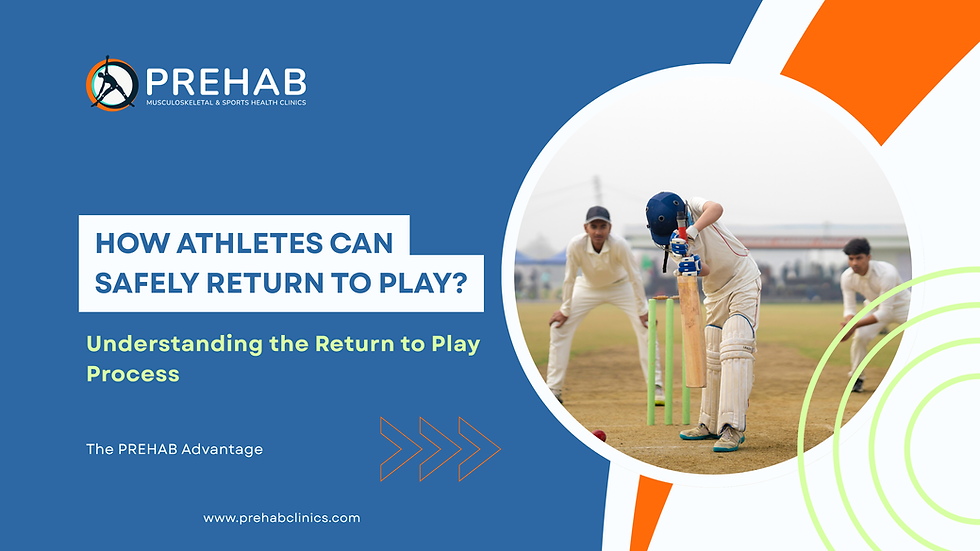How athletes can safely return to play?
- Prehab Healthcare
- Nov 14
- 3 min read
Returning to play after an injury or a long time away from the game can be daunting for athletes. The process requires careful planning, physical preparation, and a structured approach to ensure safety and effectiveness. Understanding how to navigate this journey is crucial for athletes looking to reclaim their spot on the field, court, or track.

Understanding the return to play process
Returning to play involves more than just feeling better—it requires assessing physical condition, mental readiness, and ensuring no risk of further injury. With nearly 50% of athletes experiencing at least one significant injury during their careers, a methodical approach is essential.
The PREHAB advantage
At PREHAB, we utilize technology-assisted evaluation to understand physical parameters with precision. This objective data directly improves confidence and mental readiness for both athletes and physiotherapists, providing clear benchmarks for progress.
Our athletes undergo a holistic process that includes:
· Comprehensive physiotherapy rehabilitation
· Progressive strength training programs
· Correcting strength, power, or speed asymmetries
· Overall preparation to reduce reinjury risk
For long-term injuries, we incorporate nutritional support to maintain athlete wellbeing, prevent complications, and manage weight effectively throughout recovery.
The 4 Steps to return to play

Step 1: Medical clearance
Obtain clearance from healthcare professionals who assess healing and recovery status.
Step 2: Performance parameter testing
The return to play program focuses on clearing specific performance parameters through sport-specific test batteries:
· Strength: Assessed through functional movement patterns
· Mobility: Joint range of motion evaluation
· Flexibility: Muscle length and tissue extensibility tests
· Stability: Balance and joint control assessments
· Speed: Acceleration and movement velocity measurements
· Power: Explosive force production testing
Each parameter is evaluated using musculoskeletal assessments, functional movement screenings, and technology-assisted tests tailored to your specific sport, ensuring objective benchmarks for safe progression.
Step 3: Progressive return to sport-specific activity
This crucial phase involves carefully planning training loads with calculated volume and intensity. Athletes begin with light exercises focusing on strength and mobility, then progress to sport-specific drills with gradual intensification. Each progression is monitored closely, with calculated adjustments to training volume and intensity ensuring a safe pathway toward competitive return.
Step 4: Full return to competition
The final step is a full return to competition. Even here, it is vital to remain vigilant about any warning signs. Athletes should communicate openly with coaches and medical staff regarding how they feel physically and emotionally.
Mental readiness matters
Physical recovery is only part of the equation. Mental preparedness is equally critical. Technological data and screening reports significantly influence mental preparation, providing athletes with objective evidence of their progress and readiness.
Strategies to enhance mental readiness include:
· Visualization techniques to build confidence
· Mindfulness practices to enhance focus and reduce anxiety
· Strong support systems including coaches, teammates, and sports psychologists
Creating a supportive team environment
Success in the return to play journey requires collaboration between multiple stakeholders. At PREHAB, our physiotherapists communicate and monitor athletes with the help of coaches and trainers to ensure athletes feel supported in a safe environment.
Key elements of this collaborative approach include:
Open communication: Maintaining continuous dialogue about how athletes feel during workouts and progressions
Coordinated monitoring: Physiotherapists, coaches, and trainers work together to observe for signs of discomfort or limitation
Adaptive planning: Adjusting training programs based on athlete feedback, objective data, and recovery progress
Educational support: Hosting workshops on injury awareness and prevention for all stakeholders
Team integration: Building camaraderie among team members to provide emotional support during recovery
Athletes are empowered to express their concerns and experiences throughout their journey back to sport.
Your safe return starts here
The journey back to play can be challenging, but with structured protocols and comprehensive support, athletes can return safely and sustainably. At PREHAB, we combine advanced technology, holistic rehabilitation, and personalized support to ensure your successful return to sport.
Remember: the goal isn't just to return to playing—it's to return stronger, safer, and more confident than before.
For more details contact and visit PREHAB Clinics, Bengaluru: 8867205650



Comments